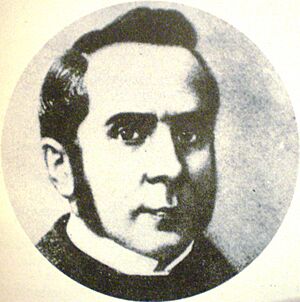José Mármol facts for kids
José Mármol (born in 1818, died in 1871) was an important Argentine writer. He was also a journalist, a politician, and a librarian. He belonged to the Romantic movement in literature.
Contents
Biography of José Mármol
José Mármol was born in Buenos Aires, Argentina. He first studied law, but soon became more interested in politics.
Early Political Life and Exile
In 1839, José Mármol was arrested. This happened because he was against Juan Manuel de Rosas. Rosas was a powerful leader, sometimes called a caudillo, who ruled Argentina at the time. Mármol was held for six days.
About a year and a half later, the political situation made him leave the country. Many other Argentines who disagreed with Rosas also had to flee. Mármol traveled to Montevideo, Uruguay, on a French ship.
In Montevideo, he met other exiles. These included famous writers and thinkers like Juan Bautista Alberdi and Esteban Echeverría.
Life in Exile and Return
Three years later, Montevideo was under attack. This was part of the Uruguayan Civil War. Rosas's friend, Manuel Oribe, led the attack. This forced Mármol to leave again. He went to Rio de Janeiro, Brazil.
He stayed there for two years. Then he tried to sail to Chile. But his ship faced bad storms and had to return to Rio de Janeiro. He stayed in Rio for another two years. After that, he went back to Montevideo. He lived there for seven more years.
Return to Argentina and Later Years
In 1852, Rosas was defeated at the Battle of Caseros. This allowed José Mármol to finally return to Argentina. He had been in exile for thirteen years.
After his return, he became a senator. Later, he was elected as a national deputy for Buenos Aires. He was also appointed to represent Argentina in Brazil.
In 1858, José Mármol became the director of the Biblioteca Nacional de la República Argentina. This is Argentina's national library. He had to retire from this job when he became blind. He passed away in Buenos Aires in 1871. Interestingly, two later directors of the library, Paul Groussac and Jorge Luis Borges, also became blind in their old age.
Literary Works
While living in Montevideo, José Mármol started three newspapers. The most famous one was called La Semana. He also wrote for many other publications.
Critic of Rosas
Mármol became known as a strong critic of Rosas. People even called him "the poetic hangman of Rosas." His most famous poem is A Rosas, el 25 de Mayo de 1843. This poem is a powerful attack against the dictator. Mármol often included strong political messages in his writings.
Other Writings
Mármol also wrote about love and had a unique way of describing things. In 1847, he published parts of El Peregrino ("The Pilgrim"). This was a long poem about his own life and travels. It was inspired by Lord Byron's famous poem, Childe Harold's Pilgrimage.
His lyric poems were collected in a book called Armonías in 1851.
Amalia: A Famous Novel
In 1844, he published the first part of his novel Amalia. This book tells a story about daily life and customs during his time. The second part of Amalia was published years later, after he returned to Buenos Aires.
In 1914, Amalia was made into the first full-length Argentine film.
José Mármol also wrote plays. These include El Poeta (1847) and El Cruzado (1851). His writing style was influenced by other Romantic writers. These included François-René de Chateaubriand, José de Espronceda, and José Zorrilla.
See also
 In Spanish: José Mármol para niños
In Spanish: José Mármol para niños


